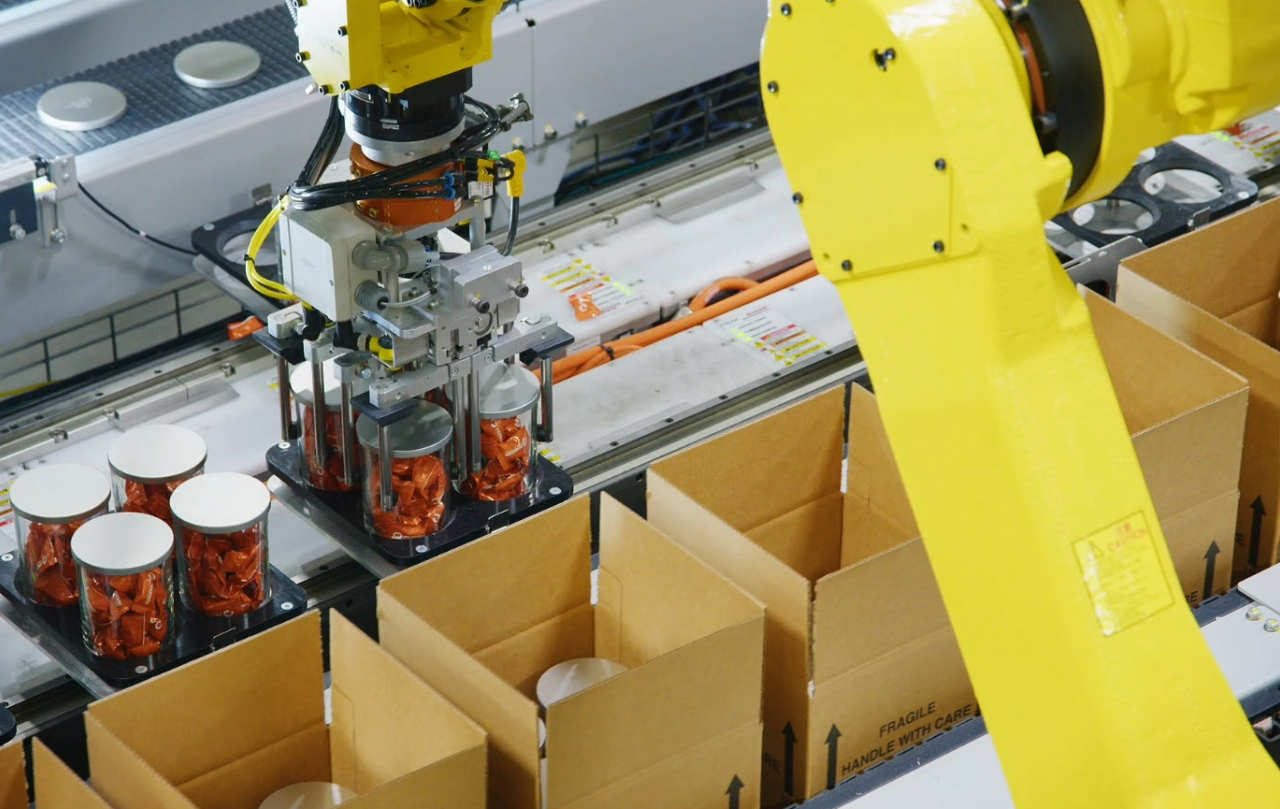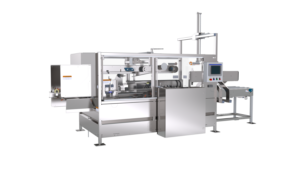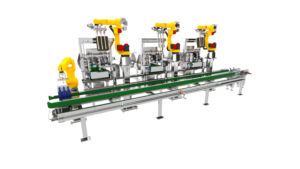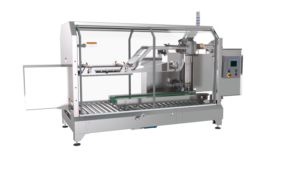System Overview
Solicitud: Product assembly, case loading and palletizing of thirteen different glass jars in varying pack configurations, in addition to a bulk palletizing option
Velocidad: 75 products and up to 18.8 cases per minute, 65 products per minute for bulk palletization
Desafíos únicos: Rapid growth in consumer demand required adding a new line within the existing facility constraints. A large product portfolio and pack configurations to meet the needs of various retail customers placed heightened emphasis on flexibility of the system
Description of Operation
The line includes a Pearson Case Erector, Robotic Inserter for bottom and top pulp trays, Robotic Jar Lidder, Robotic Top Load Case Packer, Case Sealer, and Robotic Palletizer and all associated conveying and integration.
Key system highlights include:
- Robust, flexible solution optimized for handling a wide variety of products, pack and stack patterns with maximum uptime and minimum footprint
- iTrak intelligent conveying system enables high throughput and fast changeover in a very small footprint. It requires minimal maintenance since it relies on simple, effective software profiles that increase precision and longevity instead of complex mechanical hardware of traditional conveying systems.
- Auto-tool change for case packing and palletizing robots simplify and speed up changeover process
- High-speed Fanuc robots provide extremely high uptime and reliability
- Intuitive HMI uniform across entire line with interactive guides and graphical instructions for easy and fast fault recovery and changeover
The system starts with Pearson’s CE25 case erector forming RSC cases and placing them onto a continuous-motion conveyor. Cases then continue to Pearson’s Robotic Partition Inserter, which picks a pre-formed pulpboard tray and places it into the moving box using articulated motion to avoid snagging on the flaps or case edges before continuing on to the case packer. The pulp trays will later stabilize and protect the fragile glass product in the case.
In the meantime, unlidded glass jars enter the Robotic Lidding and Case Loading Cell in a single row on a conveyor, while lids are delivered either in cases and dispensed by a robot (glass lids) or in sleeves by an operator who places them into magazine towers equipped with an automatic dispensing mechanism. Both, jars and lids then move to their individual robotic picking zones in a way that creates gaps between the products, enabling line tracking for reliable picking and placement. Two jar patterning robots then pick the glass jars and place them into the trays of the ITrack Intelligent Track System. This is a smart conveyor that combines intermittent and continuous motion of individual carts, creating a flexible and high-speed transport system that fits into a very small footprint. Capable of format changes on the fly, this seamless, in-motion process not only speeds up production but also significantly reduces mechanical complexity, minimizing downtime and operator intervention.
Placed along the conveyor track, three robots then pick the lids and securely seat them on top of the jars as the shuttle cart arrives at this station. An additional robot ensures that all lids are fully seated by gently pressing down on the full pattern before the cart moves on to the case loading station. There a robot picks an entire pattern of lidded jars and places them into the case that was previously prepared with the pulp insert.
A second partition inserter then places a top pulp tray over the jars for added protection during transport. Next, cases continue to travel through the top sealer where flaps are securely closed with pressure-sensitive tape and on to the palletizing cell.
There a robot picks a pallet from the rack and places it onto the build station, followed by picking and placing cases based on the selected pallet pattern, adding slip sheets between layers as needed. The palletizing cell also accepts a bulk line, for which the robot first places a tray onto the pallet and then completes each layer by placing individual jars into the tray and adding a tier sheet until the pallet is complete. Two multi-functioning end-of-arm tools each handle pallets, products (cases or trays and jars) and slip sheets. Changing to a new recipe is as simple as a push of a button with Pearson’s intuitive HMI and preprogrammed recipes. Switching from case palletizing to bulk palletizing is also easy and fast with built-in automatic tool change that eliminate human intervention and speeds up the changeover process.
System Components
The glass jar packaging line is comprised of the following Pearson machines. Click on the image to explore the standard product features interactively or visit the product page for more details.
Formadora de cajas
CE25
Insertador de particiones
RPI20
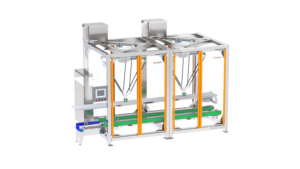
empacadora de cajas
RTL-MX
Selladora de cajas
CS25
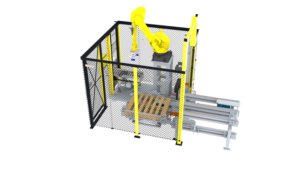
Palletizer
RPC-MX
Diseño centrado en el usuario
User centric design is about making the interaction with our machines as intuitive as possible. All Pearson machines are equipped with a uniform user interface that is highly intuitive following common website design principles, familiar icons, interactive maps and step-by-step graphical instructions. We want to reduce the learning curve for your operators and maintenance technicians, minimize the margin for human errors and make set up, changeover and fault recovery a fast and seamless process resulting in improved up time and equipment availability.


